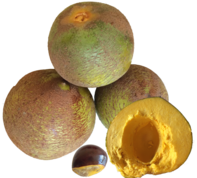Pouteria lucuma
| Lúcuma | |
|---|---|

| |
| Branchlet with leaves, flowers and fruit of Pouteria lucuma. Fruit cut in half shown on top left of image. | |
| Scientific classification | |
| Kingdom: | Plantae |
| Clade: | Tracheophytes |
| Clade: | Angiosperms |
| Clade: | Eudicots |
| Clade: | Asterids |
| Order: | Ericales |
| Family: | Sapotaceae |
| Genus: | Pouteria |
| Species: | P. lucuma
|
| Binomial name | |
| Pouteria lucuma (Ruiz & Pav.) Kuntze
| |
| Synonyms | |
| |
Pouteria lucuma is a species of tree in the family Sapotaceae, cultivated for its fruit, the lúcuma. It is native to the Andean valleys and grown in Peru, Ecuador and Chile.[1][2]
Description
Evergreen tree up to 20 m tall, greyish-brown fissured bark, presence of milky white exudate.[3][4][5] The end of branchlets and the petioles covered with short brown hairs.[4][5] Leaves simple, oblanceolate to elliptic, up to 25 cm long and 10 cm wide, glabrous (or sometimes slightly hairy on the underside) grouped at the end of the branches.[3][4] Flowers solitary or in fascicles, small, axillary, with hairy sepals and a corolla forming a tube 1-1.8 cm long, greenish white, with 5 lobes; stamens 5, staminodes also 5; ovary pubescent; style 0.8-1.5 cm long.[3][4] Fruit globose, 6–12 cm long, glabrous, russet to yellow when mature; pulp bright yellow; seeds one to several, 1.8-3.5 cm long, dark brown, glossy.[3][4]

History
Lúcuma has been found on ceramics at burial sites of the indigenous people of coastal Peru.[2] The Moche people had a fascination with agriculture and often chose to represent fruits and vegetables, including lúcuma, in their art.[6]
The fruit was first seen and reported by Europeans in Ecuador in 1531.[2][7]
Distribution and habitat
The area of origin of P. lucuma is located in the Andes of Ecuador and Peru,[5] at temperate elevations between 2,700–3,000 metres (8,900–9,800 ft).[2]
Cultivation
Attempts at growing lúcuma in Florida's climate typically fail.[2] In addition to Peru, the fruit is grown also to a limited extent in Bolivia and Costa Rica.[2] In Peru, harvesting season is from October to March and in Chile from June to November.[1]
| Nutritional value per 100 g (3.5 oz) | |||||||||||||||||||||||||||||||
|---|---|---|---|---|---|---|---|---|---|---|---|---|---|---|---|---|---|---|---|---|---|---|---|---|---|---|---|---|---|---|---|
| Energy | 414.5 kJ (99.1 kcal) | ||||||||||||||||||||||||||||||
1.5 % | |||||||||||||||||||||||||||||||
| Dietary fiber | 1.3 % | ||||||||||||||||||||||||||||||
0.5 % | |||||||||||||||||||||||||||||||
1.5 % | |||||||||||||||||||||||||||||||
| |||||||||||||||||||||||||||||||
| Other constituents | Quantity | ||||||||||||||||||||||||||||||
| Water | 64.8 - 72.3 % | ||||||||||||||||||||||||||||||
| †Percentages estimated using US recommendations for adults,[8] except for potassium, which is estimated based on expert recommendation from the National Academies.[9] | |||||||||||||||||||||||||||||||

Uses
When eaten raw, the fruit has a dry texture.[2] In Peru, it is more commonly used as a flavor in juice, milk shakes, and especially ice cream. Its unique flavor in such preparations has been described variously as being similar to sweet potato, maple syrup, or butterscotch. A dessert called "merengue con salsa de lúcuma" is served in Chile. In Peru, "manjar de lúcuma" (dulce de leche with lúcuma purée) is a dessert.
Nutrition
Lúcuma pulp has a 64-72% moisture content.[3] The pulp also contains sugars like glucose, fructose, sucrose and inositol; and acids like citric acid and succinic acid.[3] However, only limited nutritional information is available for lúcuma powder, indicating moderate content of protein and iron, each providing 14% of the Daily Value in a 100 gram (3.5 oz) serving which supplies 420 calories.[10]
References
- ^ a b "CAPÍTULO I: LA LÚCUMA (in Spanish)" (PDF). University of Piura, Peru.
- ^ a b c d e f g Morton JF (1987). "Lucmo". Purdue University, republished from p. 405–406. In: Fruits of Warm Climates. Julia F. Morton, Miami, FL.
- ^ a b c d e f g Janick, Jules; Paull, Robert E. (2008). The Encyclopedia of Fruit and Nuts. CABI. p. 837. ISBN 9780851996387.
- ^ a b c d e Pennington, T. D. (1990). Flora Neotropica Monograph Sapotaceae. New York Botanical Garden. pp. 383–385. ISBN 9780893273446.
- ^ a b c d Duarte, Odilo; Paull, Robert (2015). Exotic Fruits and Nuts of the New World. CABI. pp. 117–123. ISBN 9781780645056.
- ^ Berrin, Katherine & Larco Museum. The Spirit of Ancient Peru:Treasures from the Museo Arqueológico Rafael Larco Herrera. New York: Thames and Hudson, 1997.
- ^ Lesser-known and under-utilised plant resources Ameenah Gurib-Fakim - 2005 - Page 59
- ^ United States Food and Drug Administration (2024). "Daily Value on the Nutrition and Supplement Facts Labels". FDA. Archived from the original on 2024-03-27. Retrieved 2024-03-28.
- ^ National Academies of Sciences, Engineering, and Medicine; Health and Medicine Division; Food and Nutrition Board; Committee to Review the Dietary Reference Intakes for Sodium and Potassium (2019). Oria, Maria; Harrison, Meghan; Stallings, Virginia A. (eds.). Dietary Reference Intakes for Sodium and Potassium. The National Academies Collection: Reports funded by National Institutes of Health. Washington, DC: National Academies Press (US). ISBN 978-0-309-48834-1. PMID 30844154. Archived from the original on 2024-05-09. Retrieved 2024-06-21.
- ^ "Lucuma powder per 100 g". Conde Nast, USDA National Nutrient Database, version SR-21. 2014. Retrieved 1 October 2015.
